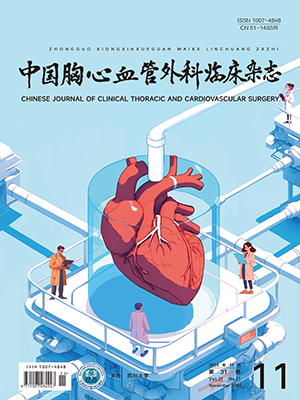| 1. |
Chen W, Zheng R, Baade PD, <italic>et al</italic>. Cancer statistics in China, 2015. CA Cancer J Clin, 2016, 66(2): 115-132.
|
| 2. |
Tachimori Y, Ozawa S, Numasaki H, <italic>et al</italic>. Registration Committee for Esophageal Cancer of the Japan Esophageal Society. Comprehensive registry of esophageal cancer in Japan, 2012. Esophagus, 2019, 16(3): 221-245.
|
| 3. |
Amin MB, Edge S, Greene FL, et al. AJCC cancer staging manual. 8th ed. New York: Springer, 2017. 185-202.
|
| 4. |
中国抗癌协会食管癌专业委员会. 食管癌规范化诊治指南. 第 2 版. 北京: 中国协和医科大学出版社, 2013.
|
| 5. |
Li B, Xiang J, Zhang Y, <italic>et al</italic>. Comparison of Ivor-Lewis vs. Sweet esophagectomy for esophageal squamous cell carcinoma: randomized clinical trial. JAMA Surg, 2015, 150(4): 292-298.
|
| 6. |
Li B, Hu H, Zhang Y, <italic>et al</italic>. Extended right thoracic approach compared with limited left thoracic approach for patients with middle and lower esophageal squamous cell carcinoma: three-year survival of a prospective, randomized, open-label trial. Ann Surg, 2018, 267(5): 826-832.
|
| 7. |
毛友生, 赫捷, 程贵余. 我国食管癌外科治疗的现状与未来对策. 中华肿瘤杂志, 2010, 32(6): 401-404.
|
| 8. |
国家卫生健康委员会. 食管癌诊疗规范(2018 版). 中华消化病与影像杂志(电子版), 2019, 9(4): 158-192.
|
| 9. |
Biere SS, van Berge Henegouwen MI, Maas KW, <italic>et al</italic>. Minimally invasive versus open oesophagectomy for patients with oesophageal cancer: multicentre, open-label, randomised controlled trial. Lancet, 2012, 379(9829): 1887-1892.
|
| 10. |
Straatman J, van der Wielen N, Cuesta MA, <italic>et al</italic>. Minimally invasive versus open esophageal resection: three-year follow-up of thepreviously reported randomized controlled trial: the TIME trial. Ann Surg, 2017, 266(2): 232-236.
|
| 11. |
Kataoka K, Takeuchi H, Mizusawa J, <italic>et al</italic>. A randomized phase Ⅲ trial of thoracoscopic versus open esophagectomy for thoracic esophageal cancer: Japan Clinical Oncology Group Study JCOG1409. Jpn J Clin Oncol, 2016, 46(2): 174-177.
|
| 12. |
Yang Y, Zhang X, Li B, <italic>et al</italic>. Robot-assisted esophagectomy (RAE) versus conventional minimally invasive esophagectomy (MIE) for resectable esophageal squamous cell carcinoma: protocol for a multicenter prospective randomized controlled trial (RAMIE trial, robot-assisted minimally invasive esophagectomy). BMC Cancer, 2019, 19(1): 608-608.
|
| 13. |
Ando N, Kato H, Igaki H, <italic>et al</italic>. A randomized trial comparing postoperative adjuvant chemotherapy with cisplatin and 5-fluorouracil versus preoperative chemotherapy for localized advanced squamous cell carcinoma of the thoracic esophagus (JCOG9907). Ann Surg Oncol, 2012, 19(1): 68-74.
|
| 14. |
van Hagen P, Hulshof MC, van Lanschot JJ, <italic>et al</italic>. Preoperative chemoradiotherapy for esophageal or junctional cancer. N Engl J Med, 2012, 366(22): 2074-2084.
|
| 15. |
Shapiro J, van Lanschot JJ, Hulshof MCCM, <italic>et al</italic>. Neoadjuvant chemoradiotherapy plus surgery versus surgery alone for oesophageal or junctionalcancer (CROSS): long-term results of a randomised controlled trial. Lancet Oncol, 2015, 16(9): 1090-1098.
|
| 16. |
Hong Y, Hui L, Yuping C, <italic>et al</italic>. Neoadjuvant chemoradiotherapy followed by surgery versus surgery alone for locally advanced squamous cell carcinoma of the esophagus (NEOCRTEC5010): a phase Ⅲ multicenter, randomized, open-label clinical trial. J Clin Oncol, 2018, 36(27): 2796-2803.
|




